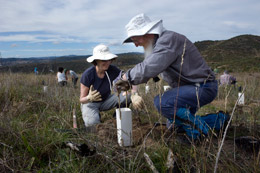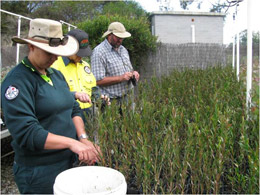ACT State of the Environment Report 2011
Accurate, timely & accessible information for the community regarding the condition of the environment, underlying pressures, and sustainability trends.
Sustainability Story: Cotter River Catchment restoration
Download: Report Stories Cotter River Catchment restoration.pdf
Revegetation and restoration work on the Cotter River Catchment has resulted in big improvements over the past four years. Thanks to the contribution of thousands of volunteers about 220,000 native trees, shrub and understorey seedlings have been planted in total. In 2010-11 alone, community members donated more than 5,100 hours and planted over 40 thousand plants. The work began back in 2006 as an important partnership between Greening Australia and the ACT Government.
To improve water quality in the Cotter Reservoir, erosion and weed control work has been undertaken along with, run-off and fire management, and monitoring and re-establishing native vegetation. The former pine plantations have been converted to native vegetation providing much improved habitat and protection from predators for rare and threatened species such as the Macquarie Perch, Murray River Crayfish, Two-spined Blackfish and Key's Matchstick Grasshopper.

Greening Australia community planting event (Photo courtesy of Greening Australia)
In March 2011 the Yurung Dhaura Land Management Team, of four Indigenous Trainees and a Team Supervisor, were engaged on a two year contract by the ACT Environment and Sustainable Development Directorate in partnership with the Territory and Municipal Services Directorate. Yurung Dhaura, Ngunnawal for Strong Earth, was named by the local United Ngunnawal Elders Council, and will work to restore at least 6.4km of streambank and 76ha of high conservation ecosystems.

Members of the Yurung Dhaura Team and their Supervisor preparing seedlings for planting at the Greening Australia nursery (Photo courtesy of ACT Natural Resource Management Council)
The team, who are combining their work with study in Conservation and Land Management at the Canberra Institute of Technology, will implement a series of improvements. These include assessing and controlling pest animal numbers, surveying native fauna and flora, track repair and maintenance and fencing sensitive areas of the Ramsar-listed sphagnum bogs.
Trainees will also monitor water quality, collect native tree seeds and propagate tree seedlings for environmental restoration. The team has laid pig baits over an area of more than 100ha and removed more than eight hectares of dense pine wildling in an area of Xanthorrhoea (grass trees), exceeding project targets to date. The Yurung Dhaura team is also working with the Ngunnawal people to document Traditional Ecological Knowledge in the region, and apply this knowledge where permitted, to biodiversity conservation in the catchment.
The Cotter River Catchment project has attracted many partners including the United Ngunnawal Elders Council, Canberra Institute of Technology, the Board of the Ngunnawal Healing Farm, ActewAGL, Greening Australia, the Southern ACT Catchment Group Waterwatch Program and the local Aboriginal community. Restoration work will continue in the lead up to Canberra's centenary and the completion of the enlarged Cotter Dam. Consolidating improvements in water quality and biodiversity will enhance the stability, health and resilience of the Cotter River Catchment.
For more information see the ACT Government Territory and Municipal Services website, www.tams.act.gov.au






Share this page: